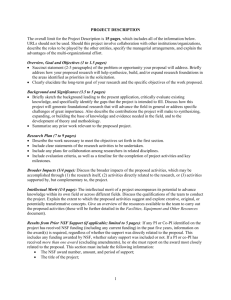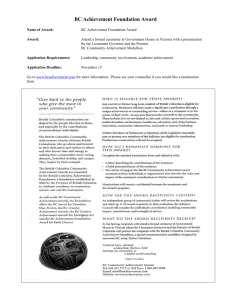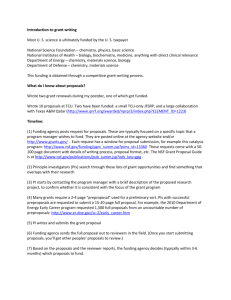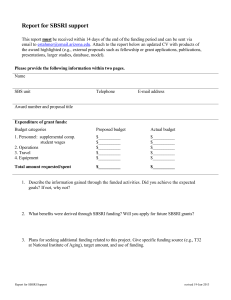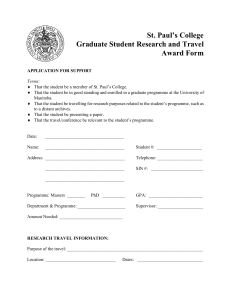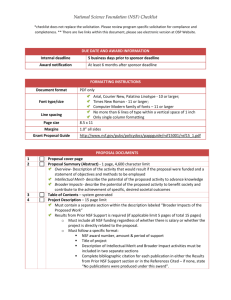research - School of Engineering
advertisement
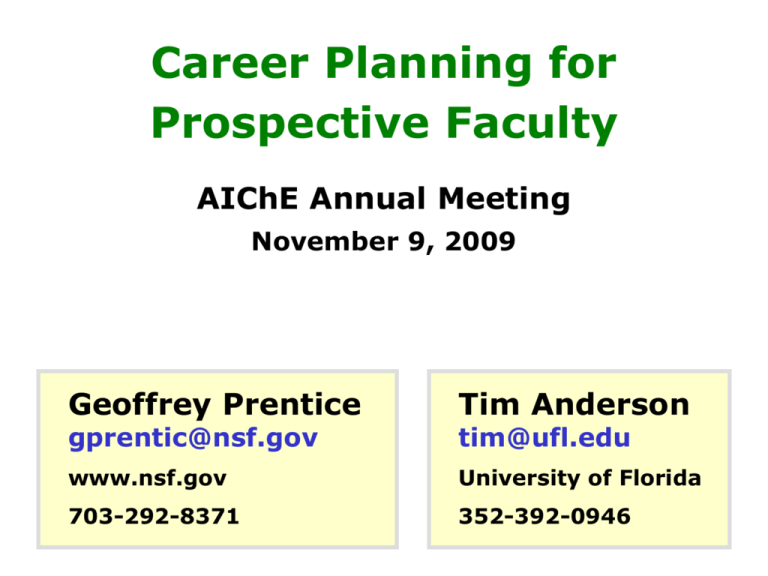
Career Planning for Prospective Faculty AIChE Annual Meeting November 9, 2009 Geoffrey Prentice Tim Anderson www.nsf.gov University of Florida 703-292-8371 352-392-0946 gprentic@nsf.gov tim@ufl.edu Workshop Agenda • • • • • • • Welcome and Introductions New Faculty Success Strategies New Faculty Career Planning Writing Proposals Research Career Planning Applying to the NSF The CAREER Award Workshop Agenda • • • • • • • Managing Research NSF Engineering Overview Identifying Research Problems Developing Research Proposals Contacting Funding Agencies Time Management Evaluation & Closing Remarks Comments Presentation will highlight key points Many slides will be hidden – mostly informational Full presentation at http://www.nsf.gov/eng/cts/about.jsp Designed to be an active workshop – please ask questions / add experience 4 New Faculty Success Strategies 5 What Do We Know About New Faculty Development? Very little study of new engineering faculty development Can be stressful What is the most stressful aspect of being a new faculty member? 6 Exercise Write on this page what you expect to find most stressful about becoming a faculty member Break into groups of 4-6, introduce yourselves, and share this information 7 What Do We Know About New Faculty Development? Stress Points (Sorcinelli, 1992) Not enough time Inadequate feedback and recognition Unrealistic self-expectations Lack of collegiality Balancing work and outside life Faculty Characteristics (Boice 1991, not limited to engineering faculty, extremes) Quick Starters Unsuccessful Seek social support / advice Confused about expectations Exemplary teachers Feel socially isolated positive attitude towards students less time preparing for class more time on scholarly work complain less Scholarly work only verbal priority, low actual time Defensive teachers lecture only content focus avoid bad evaluations 9 Success Strategies Slide 1 of 2 Schedule regular time for scholarly writing (proposals, papers, reports); keep time log 30-45 minutes daily or 2-3 longer blocks weekly Keep record of time spent on all activities Limit preparation time for class (especially after the first offering) < 2 hours preparation for 1 hour of lecture Keep track of time spent in time log 10 Slide 2 of 2 Success Strategies Network at least 2 hours / week Visit offices, go to lunch, have a cup of coffee with colleagues in and out of the department Discuss research, teaching, campus culture Develop clear goals and a plan to reach them Get feedback on plans from department head, mentor, other colleagues, and make adjustments Use planning tool (e.g. Gantt chart to plan course development, research, presentations, publications) Periodically review progress (at least annually) 11 Collegiality & Service Be friendly No excuse for surly, rude behavior Service – Projects Pick one you enjoy & make it yours (e.g., contest for high school day) Service – the Commons Do your share (but not more) of committees, homecoming, visitors and so forth. New Faculty Career Planning 14 “If you don’t know where you are going, any road will get you there.” The Cheshire Cat Alice in Wonderland SNAFU®by Bruce Beattie Valley Daily News Nov. 13, 1988 Components of Career Planning Research Career Teaching Career Professional Career Personal Career Career Elements Are Connected 14 What Does University Want? Research University Teaching Institution • Money • Great Teaching • Impact & Fame • Collegial & Service • Good Teaching • Money • Collegial & Service • Impact & Fame Missions Goals What you have a passion for . . . What you would hope to accomplish . . . What are your strengths? You decide vs. others decide What do you like learning? Routine vs. non-routine What outcome would you like to see? Idealistic vs. realistic Who do you admire? Growth goals May change with time 16 Implementation Establish realistic balance; eliminate goals if necessary Implement in context of your situation (institution, family, health, finances…) Revisit periodically – goals change Obtain feedback and tune (chair, colleague, mentor) Keep it visible (e.g., white board, Gannt chart) 24 Writing the Proposal 25 Successful Proposals Stress the novel aspects of your approach Differentiate your work from that done by others Emphasize the hypothesis that your research will test Respond to all aspects of the program description Support your ideas with references / preliminary results Describe applications that could result from the research Show where the research might lead Include figures and graphs to facilitate understanding – teach not snow 26 Common Sections I. Slide 1 of 2 Project Summary II. Project Description A. Results from prior agency support B. Statement of problem and significance C. Introduction and background Relevant literature review Preliminary data Conceptual or empirical model Justification of approach or novel methods 27 Executive or Project Summary Most important section (initial impressions, often used for reviewer selection) Contains goals and scope of study, significance, brief description of methods, hypotheses and expected results Clear, concise, accurate, exciting Particularly important with panel reviews Usually 1-2 pages Conventions vary by field – seek samples 34 Slide 2 of 2 Tips Contact program monitors Meet at professional societies Volunteer to serve as reviewer Submit early ~ 1% NSF proposals returned Federal fiscal year begins October 1 42 Research Career Planning Note: This workshop will focus on establishing and developing a research career, but encourage you to attend other workshops on teaching (e.g., NETI) and professional development. 45 And I Get Paid to Do This! Work with young, bright and eager students Perform research on topics of my choice (to a degree) Sabbatical every 7th year Travel Enjoy colleagues in own and other disciplines, around the world Retire gracefully And have great job security (tenure) 49 Research Career Develop 5-year and long term plans and revise (at least annually) Peer recognized excellence (‘potential’ required for tenure at most institutions) in research area is long term goal Important to remain research active throughout career (traditional graduate program, REU’s, collaborate with industry, sabbaticals, education research . . . ) 50 Research Hierarchies Chemical Engineering Electronic Materials Processing CVD of semiconductors Bulk crystal growth Solid-state sensors Research Discipline Research Field Research Area p-type doping of GaN Research Issues Cluster doping Problem Solution Established Likely fixed (sometimes different than Ph.D. topic) Only a few in one’s career Distinguishes Innovative 53 Slide 1 of 3 The Numbers ($) Graduate students: 5 yr. before first PhD & continuity, 1 PhD/yr = group size 6-7, 40 yr career = 35 PhDs in career 35 solutions; ~20 problems; few research areas in career Grad. student cost: $22K (stipend)+11K (overhead)+7K (tuition) = $40K/yr $280K (7 students) + 50K (3 summer mo) = $320K + cost of research (~30K/student) = $530,000/yr funding Slide 2 of 3 The Numbers ($) The department investment: Chair’s view Salary: $70K/yr for 6 yr = $420K Start-up (variable): students, summer salary, equipment, supplies, reduced teaching service assignment, . . . = $400K Total = $820K Slide 3 of 3 The Numbers (time) Idea to publication: 3 to 7 years t= + + + + + + + = 0 (idea) + 3 mo (preliminary results) 2 mo (write proposal) 3-6 mo (review) 1-13 mo (funding cycle - note 10/1) 0-12 mo (identify graduate student) 12-36 mo (do research) 3 mo (write manuscript) 6-15 mo (submit / review / publish) 30-90 months Already Have Grant or Do Without $ Theory/Modeling t=0 idea + 1-3 months, theory/simulations + 1-3 months, write + 6-15 months, submit, review & publish = 8-21 months Experimental t=0 idea +3-12 months, experiments +1-3 months, write + 6-15 months, submit, review & publish = 10-30 months Identifying Research Area and Issues in your Field Extension of thesis or post-doctoral research Easiest but competing with former advisor(s) Tangent to thesis or post-doctoral research Easy transition but credibility not fully established New area Longer time constant & higher risk, but return may be high; consider collaboration (your contribution must be recognizable) 57 Your Academic Career 40 years as a faculty ~20 research problems 35 PhD students 140 publications $15 million in funding 300 proposals 70 courses taught >2000 students 6 chairs, 7 deans and 8 presidents 4 sabbaticals 2080 Saturdays Office of International Science & Engineering (OISE) Promoting International Collaborations NSF Program Officers Orientation 56 OISE & International Activities at NSF OISE supports international activities Foundation wide: • Co-fund new proposals submitted to NSF disciplinary programs • Co-fund supplements to existing NSF grants • New proposals to OISE Key elements for OISE co-funding: • Intellectual collaboration • Leverage expertise and resources • US junior researchers and students 58 Applying for NSF Grants 60 Award Criteria Intellectual merit Importance in advancing understanding in a field Creativity and novelty of approach Qualifications of investigators Completeness of research plan Access to resources Broader impacts Promotion of teaching and training Inclusion of underrepresented minorities Enhancement of infrastructure & partnerships Dissemination of results Benefits to society Finding an Appropriate Program Check list of currently funded programs Use FastLane Read titles and abstracts on the website Find a fit Contact program director Prepare a one-page abstract Specify appropriate program on cover sheet Consider initiatives and special programs Sensors initiative NSE initiative Award List for Program: SEPARATIONS and PURIFICATION PROCESSES [ Click on the Award Number for Additional Information (on Web) ] Multicomponent Space-Charge Ion Uptake and Ion / Solvent Transport Models for Ion-Exchange Membranes Award#: 0331389 Current Year Award Amount: $0 Cumulative Award Amt: $166,310 Estimated Total Award Amount: $166,310 Original Start Date: Sep 01, 2002 Projected Duration: 12 Months PI: Pintauro Institution: Case Western Reserve State: Ohio District: 00 New Pressure Swing Adsorption Processes Award#: 0327089 Current Year Award Amt: $90,366 Cumulative Award Amt: $90,366 Estimated Total Award Amount: $277,155 Original Start Date: Aug 01, 2003 Projected Duration: 36 Months PI: Wankat Institution: Purdue University State: Indiana District: 07 SGER: Distillation Using Hollow Fibers as Structured Packing Award#: 0322882 Current Year Award Amt: $49,937 Cumulative Award Amt: $49,937 Estimated Total Award Amount: $49,937 Original Start Date: Jun 01, 2003 Projected Duration: 12 Months PI: Cussler Institution: Univ of Minnesota-Twin Cities State: Minnesota District: 05 Distribution of Average Reviewer Ratings FY 2005 Number of Proposals: 41,758 ( 31,966 Declines & 9,792 Awards ) Final Thoughts Contact program directors Meet at professional society conferences Volunteer to review proposals, e.g., http://www.nsf.gov/eng/cbet/reviewer/ Examine successful proposals Ask colleagues for their proposals Get proposal reviews from colleagues Suggest reviewers for your proposal Use FastLane form provided Faculty Early Career Development Program (CAREER) NSF Announcement 08-557 2008–2010 Submissions 70 CAREER Proposals Critical Elements Research and education Departure from Ph.D. work Special Considerations Panel review - - bring reviewers up to speed Read current announcement: rules change PI specifies program for initial assignment Logistics Submit early and resubmit if necessary Follow-up: check for successful submission Fix errors through FastLane before deadline 74 About 1% of proposals returned unreviewed CAREER: Departmental Letter Departmental Letter (about 1 page): Include integration of research and education Describe the departmental/institutional support Verify the self-certified PI eligibility information 75 ENG CAREER Proposal Success Rates 83 CBET CAREER Success Rates FY 2004 - 2009 400 20% 300 15% 200 10% 100 5% 0 0% 2004 2005 Proposals 2006 2007 Awards 2008 2009* Success Rate *FY 2009 Data expected. 84 Obtaining DoE Funding National Research Funding Source: AAAS 2009 estimate does not include ~$21 billion in stimulus funding for federal R&D (~$17 billion research) Main Funding Energy Offices • Office of Energy Efficiency and Renewable Energy Alternative & renewable energy, energy efficiency, business development, & superconductivity. • Office of Fossil Energy Electric power, oil, gas, & coal technologies. • Office of Nuclear Energy, Science and Technology Nuclear energy, isotopes, and nuclear facilities management. • Office of Science Basic science, advanced computing, biological and environmental research, fusion, high energy and nuclear physics, materials, and medical. Obtaining NIH Funding 93 The National Institutes of Health • Conducts and supports medical research • Composed of 27 Institutes and Centers • $30.6 Billion (FY 2009 Budget) 84% extramural support http://www.niaid.nih.gov/ncn/grants/default.htm 94 Obtaining DoD Funding Observations: DoD Funding • White paper approach is effective • Program officers often conduct research • Faculty Fellowship Program is effective means to establish a relationship • The agencies report to the “Generals” • The art of discerning directed RFPs – short time line – anticipated total award/number awarded – review process Managing Research Now that you have funding! 101 Guiding Observations Every student is different There is not a single correct management style When in doubt ask: What is best for the student? Reasons Grad Students Fail Project too difficult or unmanageable Student lost interest in topic Student isolation Poor planning and project management Writing the dissertation Few problems if turn in parts while still doing research Personal problems: Money is #1 Inadequate or no supervision (22% of Graduate Students in survey) Identify something your advisor did that was effective in managing the group. Student Project Definition A Four-Step Process Step One: Select Student Keep a sharp eye in the classroom Participate in the recruiting and application review process Impress on the student that this is the most important decision they will make in graduate school! Student Project Definition A Four-Step Process Step Two: Involve the student in defining the project. It is a periodic process. Teach student how to define research problem Scientific method Synthesis of literature Grant/contract requirements must be met Funded project likely more successful (peer reviewed, long term support) Student Project Definition A Four-Step Process Step Three: Incorporate early milestones e.g., specific classes to take, a report, first paper or presentation, a piece of equipment designed, literature review, hypotheses / broad objectives, etc. Establish a 2-way “probationary” period Establish a timeline for project Require regular progress reports Student Project Definition A Four-Step Process Step Four: Establish the research committee Help the student choose the committee, impressing on them the purpose of a research committee Have the student present her/his hypotheses (depending upon department rules), objectives, and any initial results to her/his committee within the first year. Group Meetings Periodic group meetings are helpful Presentations, guests, lectures, paper reviews, book chapters, special events Meet with other groups occasionally Keep it technical Social events Holiday party, picnic Individual Meetings Establish mechanism for regular meetings Every student is different Identify strengths, weaknesses Academic children Clearly convey your expectations Faculty Role You are the research advisor not fellow student Maintain professional relationship Thesis is authored by 1 person You are role model, academic counselor, consultant, sounding board, evaluator, supporter, editor, agent Establish traditions / build pride Hardbound dissertation, dinner, pedigree chart, . . . Maintain contact 113 Student Evaluation and Feedback Develop an evaluation process Slide 1 of 2 Examples: Formal process (e.g., your University may have a process), biweekly meetings, group meetings Build in methods to detect problems early Sample writing, timelines, independence, professionalism, … It is never inappropriate to send words of “thank you,” “job well done,” and “good luck” or to likewise let them know that you are expecting better things from them! Students are usually better than you think!!! Don’t be afraid to challenge them!!! 140 Student Evaluation and Feedback Slide 2 of 2 Utilize peer group Feedback on presentations, research plan, writing Return material in a timely manner Seek advice Counselors, other faculty, international office, … 141 Other Personnel Undergraduates Realizing good productivity by UG’s challenging Let graduate students advise Ugs Well defined/scoped project required Post-doctoral researchers More productive, less guidance, assist in directing graduate students Select carefully Remember their objective is to find next job Cost issue 146 Other Personnel Technicians They provide continuity / institutional memory Involve in education as well Remember this is their career Staff can be very helpful – treat with respect 147 Budget Management Check expenditures routinely (monthly) But don’t spend too much time. Let system work for you! Early on, have the administrative staff in your department and College explain their roles in the budget process ‘Bank’ fund – overhead account/Foundation If trouble predicted, tell folks Use educational institution discounts ‘training future customers’ rationale 156 When/What to Disclose • WHAT: Disclose novel ideas, discoveries, inventions that are timely and useful to the marketplace • WHEN: Disclose with sufficient notice before any publication (prior to submission) or enabling public disclosure • Don’t know if you should disclose? Call local office of licensing/technology University Owns Employee Inventions When: • The invention was made while you were employed at university AND • The invention is in the field/discipline in which you are/were employed OR • The invention was made with university resources Engineering Directorate Activities Engineering Directorate FY09 Research Themes • Cognitive Engineering: improves understanding of the brain and nervous system for engineering novel systems and machines. • Competitive Manufacturing and Services Enterprises: Catalyzes multiscale manufacturing from fundamental metrology through atomic-scale control of raw materials. • Complexity in Engineered and Natural Systems: Addresses unifying principles that enable modeling, prediction, and control of emergent behavior in complex systems. • Energy, Water, and the Environment: Supports breakthroughs essential to energy and water sustainability. • Systems Nanotechnology: Leads to development of active and complex nanosystems integrated with biology, energy, and other fields. Engineering contributes at all scales. Examples are nanotechnology, computational simulation, health, and alternative energy. 148 ENG Research Themes • These Research and Education Themes for FY 2009 Define Transformative Research Directions • Address key challenges identified in American Competitive Initiative and America COMPETES Act Source: FY2009 Budget Request to Congress 149 New NSF Programs SGERs OUT: ‘EAGER’ & ‘RAPID’ IN – EAGER • High-risk, exploratory and potentially transformative research requests up to $300K and two years duration – RAPID • Quick-response research on natural or anthropogenic disasters and similar unanticipated events. Requests may be for up to $200K and one year duration – Starts on January 5, 2009 – Submit anytime, but must talk to Program Director first 150 Emerging Frontiers in Research and Innovation (EFRI) EFRI focuses support on important emerging areas in a timely manner Typically, the annual budget for EFRI will be 3-to-5 percent of the Directorate budget (~$15-to-$30 million) It is expected that the investment in any topic will range from $3 million to the total annual ERFI budget 154 Developing a Research Proposal 159 Developing a Research Proposal: Overview Slide 1 of 2 Identify and describe the conceptual framework Review relevant literature for problem and related problems Articulate the general research question in context of above Formulate set of hypotheses 161 Know the Proposal Review Process External Panel In-house Review criteria Background of reviewers 167 If Proposal Not Funded Read reviews – consider resubmission Minor problems noted: poor proposal organization, references insufficient Reviewers did not seem to appreciate innovations: re-emphasize key elements Mixed reviews: stress aspects of proposal relevant to negative comments Contact program director for advice: is resubmission recommended? is research area a priority? what is the funding situation? 167 If Proposal Not Funded - 2 Read reviews – consider other options Consistently low ratings: usually an indication of weak or incremental research Consistently high ratings: is little funding available? is research area of low priority? Is the work more appropriate for another agency or industry funding? Usually helpful to contact program officer if resubmission is being considered 168 Resubmitting a Proposal Rewrite the proposal by incorporating changes based on reviewer comments For NSF, addressing reviewer comments in a separate section is not recommended; other agencies require a separate section The title need not be changed if the scope does not change In most NSF directorates many new panelists will review your resubmission 169 Contacting Funding Agencies Why Contact Program Officer Establish credibility Guidelines on how to shape your proposal to match program needs Increase funding probability Save time Who to Contact Identify suitable agency Identify suitable person at agency Ask colleague/advisor Search website Read solicitation Industry: research expert Professional meetings Other networking opportunities How to Contact the Program Officer Email Solicitation,website Simple questions, phone appointment Phone call Prepare questions in advance Be professional and yourself Listen carefully Other Ways to Contact Program Officer Attend open workshops Attend agency conferences Meet with at professional/research society meetings Get on schedule during campus visits Invite for seminar Volunteer to review, especially panels Tips Federal fiscal year begins 10/1 Get involved in proposing program ideas Attend program reviews when appropriate Time Management Academic Freedom Lots of it and no personal assistant! Academic tasks Non-academic tasks • teaching • research • book writing • calendar • filing • student recruiting Mandated time • classroom • grading • report writing • committee meeting Discretionary time • literature reading • proposal writing • email • session chair Time Management Exercises Write down the most important time saver that you use Write down the largest time waster you face Share tips Know Yourself Perform time audit For one week write what you do every 30 min When do you work best? Internal – time alone External – time in groups Cannot do everything – know priorities Decide flexibility level you can tolerate Urgency Task Classification III I IV II Importance Tips 55 hours/week doing professor stuff is about right More productive, creative, accurate Touch stuff only once, if possible Ask for help when needed Delegate with clear instructions of expectations More Tips Schedule meetings at office of others – you can leave Know your business and say no to other’s Learn to say no nicely “I’m sorry, but I’ve just got too many other commitments right now.” “Good talking to you, but I’ve got something I need to attend to now.” Learn to finish Don’t keep revising (perfectionist) needlessly One writing/proofing on low importance items Keeping track of it all Use a calendar Develop own system Schedule all priority activities: research, writing, student advising/direction, professional development Schedule teaching preparation time (not too early or late – will make a better teacher) Schedule large blocks of time Understand work ‘start-up’ time, location Schedule personal time Vacations, growth, extra fun day on travel Stick to it (as much as possible) Others will adapt Keeping track of it all Use a to do list Card system, PDA, Outlook Identify time for daily update Filing system vs. Piling system Decide appropriate level of effort Larger chunks, delegate, electronic Develop system for time sensitive stuff (Optimal) Procrastination Fun vs. urgent vs. important activities Fear factor is often cause Break into smaller tasks Schedule it Delegate it Reward or punish self E-mail Don’t check e-mail 1st thing in the morning (do something important 1st, e-mail’s an excuse). Don’t check e-mail in late evening (interferes with sleep). Minimize exchanges: ‘propose not ask’ Suggest solutions, use ‘if then’ Unsubscribe if you don’t read Fewer and more concise message If message train longer than 3, phone E-mail Assume that your e-mail messages are not private. Never write a “hot” e-mail message. It is too easy to send by accident. Don’t ever send messages when you are angry. Make e-mail brief and proof-read it. Don’t read other people’s e-mail. Respond to e-mail in batches. Time Management #1. Set goals & prioritize. #2. Delegate. How can we do this? To secretaries & assistants To graduate students and undergraduates as part of learning experience. (They don’t work for you!) Give clear assignments & responsibility for details. Check on results & give feedback. Give credit. #3. Use efficient processes. Closing Remarks Establish Credibility • Amongst peers, research community, funding agencies • Methods include – Write review articles, attend meetings, visits to funding agencies – Presentations, workshop mode conferences – Review panels, volunteer in societies, white papers – Seminar chair, request papers, preliminary results • New faculty often given special consideration CAREER DEVELOPMENT WORKSHEET 4 COMMON OBJECTIVES FOR NEW FACULTY 1. Build Network in Community List 5 Research Peers: 1____________________ 2_______________________ 3_____________________ 4___________________ 5________________________ List most important conference/workshop you should attend: research: _______________________________________ professional:_______________________________________ education: _______________________________________ List eight senior professionals who will be asked to write recommendation/evaluation letters: 1_____________________________ 2______________________________ 3____________________________ 4______________________________ 5____________________________ 6______________________________ 7____________________________ 8______________________________ What is the leading laboratory/group in your field? _______________________________________________________ CAREER DEVELOPMENT WORKSHEET 4 2. Establish Credibility List the two best journals in your field: 1._________________________ 2._________________________ Title of review article to be written in next five years: _______________________________________________________ What is the most original idea you are now working on? What award should you be nominated for in the next five years? Attitude • Don’t take yourself or tenure race too seriously. – Tenure doesn’t help if you’re dead. • Lighten up – Humor & laughter – Bad things happen to all professors – don’t dwell on them or let them get you down. – Take the university as it is – reform it later. • Take care of yourself – Eat right, exercise, sleep enough – Spend time with “family” • If you know something is right thing to do – do it! Please take a few minutes to complete our survey Good Luck!
